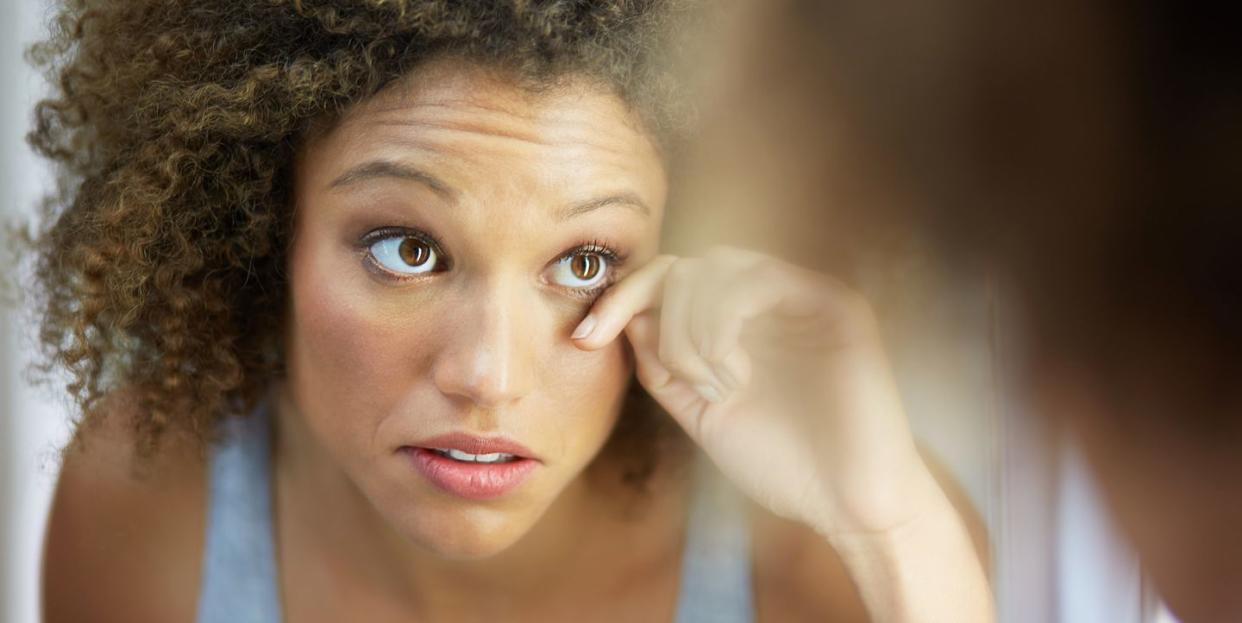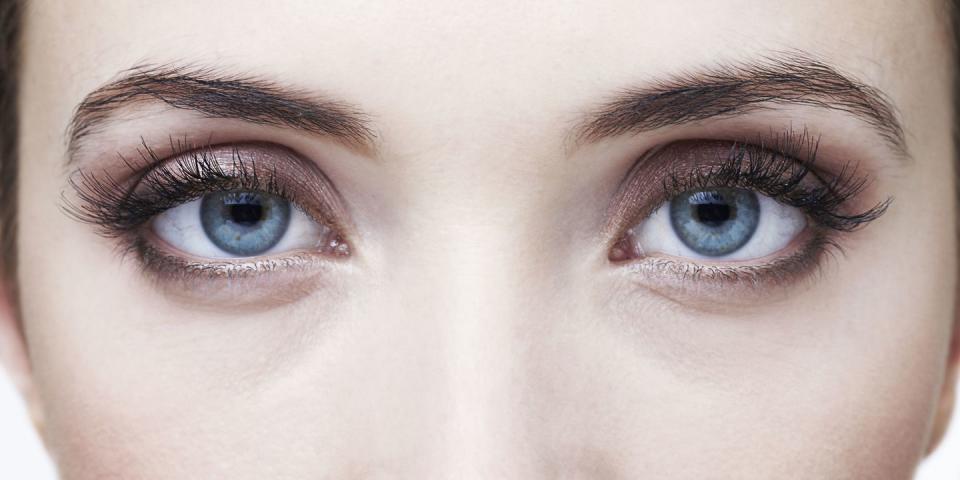How to get rid of bags under eyes

For some of us, it doesn't matter how much sleep we get: under eye bags still won't shift. Puffiness or swelling in that area is common with age.
While they rarely signals anything to be concerned about, many of us seek to disguise them for cosmetic reasons. Figures from the British Association of Aesthetic and Plastic Surgeons (BAAPS) show that eye lift surgery – blepharoplasty – is still near the top in popularity out of all cosmetic procedures performed in the UK with 2820 women and 333 men having the procedure in 2019.
What causes bags under eyes, and how can we get rid of them? We asked the experts.
Causes of bags under eye
Plastic surgeon Rajiv Grover explains, "Eye bags are caused when the thick membrane that holds back the fat under the eye socket begins to weaken and the fat starts to bulge forward. In some people, this starts in their thirties because they have a familial tendency to have a weakness in the lower lids and, unfortunately for this group, it's unpreventable. Leaving them aside, many people get eye bags as they age. The membrane gets weaker and the muscle tone also gets weaker. Sun exposure and smoking can also play a part in the skin itself losing elasticity in the under eye area."
Consultant dermatologist Dr Nick Lowe explains that loss of volume or weight in the cheeks can make the problem more obvious, but weight gain can also exacerbate eye bags, as it can lead to fatty pockets under the eye. So is there any hope?
Dr Lowe cautions that anyone who's concerned about severe eye bags should have them checked out by a doctor before seeking out cosmetic treatments to check it's not something more serious.
"Occasionally people can mistake puffy eyes for eye bags. Puffy eyes can be the symptom of a number of diseases, such as thyroid disease, hormone diseases, where excess cortisone is produced and kidney disease as well as certain skin conditions like eczema."
If you're sure your bags are just a cosmetic problem, here's how to tackle them at any age.
In your 20s
Getting a minimum of seven hours sleep a night and avoiding excess alcohol and salt may help. If you've been burning the candle at both ends, bags under your eyes will probably respond well to these low cost, home remedies:
Tea bags: use tea bags, gently squeezed of excess water and cooled in the fridge and then placed over the eyelids for five to ten minutes. The cold tea bags mould to the shape of the eye and infuse the eye area with polyphenols and caffeine which can help reduce puffiness.
Egg whites: about 50 years ago people used to apply egg white to the skin of the eye to tighten it. As it dries it goes hard and contracts. Anything that can improve the tone of the skin or muscle can push back the fat. If it's a big bag it won't be stopped by egg white, but with early bags you can sometimes make an improvement.
Cream: thankfully there's a cream that works in the same sort of way that doesn't involve covering yourself in egg white. Eyesential, a product which tightens the lower eyelid skin as it dries and can make a huge difference.
There are many products now out on the market including Wunderbrow Wunderlift and it is a case of seeing what works for you. For example Wunderlift has some pigment in it to help conceal undereye pigmentation and is best applied at least 2 minutes prior to make up and you should avoid concomitant use of oil based products. It is better with all of these products to use the adage 'less is more' so the drying effect looks more natural and does not dehydrate the lower eye area completely.
In your 30s and 40s
By the time you've reached your mid to late thirties, you may find your usual eye bag armoury isn't cutting it, particularly if a baby or two has been thrown in to the mix.
This is a good time to invest in a nourishing eye cream. Although the effects are unlikely to last more than a day, a cream that contains caffeine should make the under eye skin contract a little, reducing the appearance of eye bags in the short term.
Eye creams and serums that contain peptides and antioxidants can also help to reduce inflammation and puffiness.
"I would suggest using a Prescription Retin-A cream two or three nights a week (although avoid this if you have sensitive skin) and alternating with a moisturising eye cream on other nights of the week to counteract the irritant effect of the Retin-A. You have to obtain a prescription from your GP or dermatologist, and ask for one that contains 0.05% Retin-A," says Dr Lowe.
If you are going to use a Retin-A product on this delicate area discuss with your dermatologist first and be aware of side effects such as irritation or initial sensitivity and the need for a sunblock to protect the skin while using it.
You must still prioritise sunscreen with a retinol product.

Surgical and interventional treatments
If that's not having the desired effect, you might need a little more help: "Now may be time to look at slightly more invasive treatment options," says Rajiv. One alternative is the use of tear trough fillers, which cost around £500 and fill in the dip that appears between the eye and cheek as we age.
"Bags are created not just by the fat around the eye coming forward but also the cheek fat descending as we age. I liken it to the tide going out on the beach. In a young person the sea is flush with the beach (or the cheek is flush with the lower eye lid.) As we age the tide goes out: the cheek fat disappears and descends. By injecting a little bit of filler in to the tear trough, the dip of the lid-cheek junction is gently erased. This is a delicate treatment and needs to be performed only by a specialist with accurate knowledge of the anatomy of the eyelid and as with many treatments it is important to be cautious. Less is most definitely more."
However, it's worth knowing that not all experts agree on the effectiveness of this treatment. Dr Lowe says: "I strongly disagree with tear trough fillers as I believe fillers near the eye can cause discolouration, giving the appearance of dark circles. It's important to note there's a variance of opinion here." Finding the right treatment for your skin and face is the real key.
Dr Lowe recommends radio frequency Thermage to tighten the lax membrane associated with eye bags. "Or if you have eye bags and loose skin, then Fraxel carbon dioxide Laser treatment can be effective at tightening the loose skin in the under eye area," he says. A cosmetic dermatologist can help explain these treatments in more detail and help you decide if they're right for you
Whatever surgical or interventional option you choose, make sure it is with a fully qualified Doctor or Surgeon trained in the appropriate specialty, ideally by recommendation and ask to see evidence of their work prior. They should counsel you thoroughly about the risks and side effects of any procedure and this could be incredibly serious in an untrained practioner's hands as they are working around the delicate eye area.
In your 40s, 50s and beyond
Choose an eye cream that targets fine lines and wrinkles as well as puffiness, as these are the things that tend to make eye bags look worse. Read the reviews and try samples before investing in the products if you are cautious. Have patience and see if there is a difference after six to 12 weeks.
If this isn't working for you, it could be time to bring out the big guns. As a last resort, lower lid blepharoplasty (which costs from around £3000) can offer a permanent solution to eye bags, but it's not without risks.
The surgery, which can be done under local anaesthetic and as a day case, involves making small incisions in the inside membrane of the lower lid. Some of the fat under the eye is removed and the remaining fat is spread out to fill out the eye socket so the patient isn't left with a hollow, sunken look. The op is best suited to younger patients whose lower lids pass the 'snap test.'
Rajiv explains, "In some cases – older patients who may have a floppy lower lid - there is a risk that the lower lid can be brought down further by surgery creating a blood hound look, so it should be treated with caution and not rushed into. We categorise according to risk. If you pinch the lower lid in a snap test and it goes back quickly that indicates they still have elasticity and the patient is in a low risk category."
Whatever intervention or strong topical treatment other than home eye creams and remedies you decide on for dealing with eye bags, it is essential to talk to an experienced practitioner to discuss all of your options beforehand and do not proceed if you feel at all pressured.
Last updated: 22-04-2020
You Might Also Like


